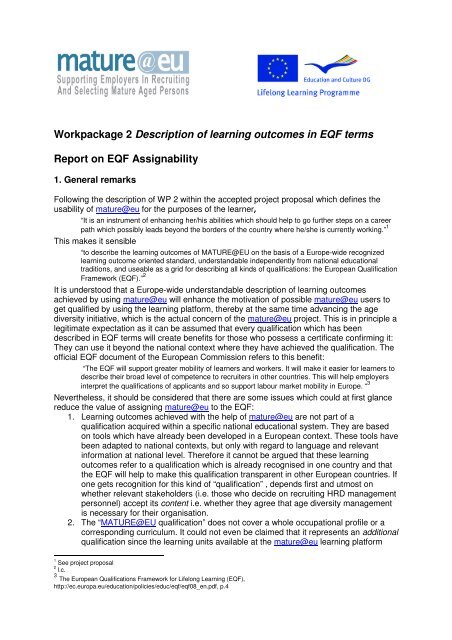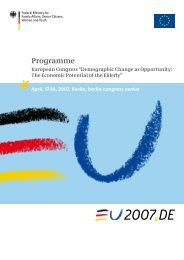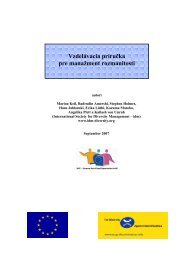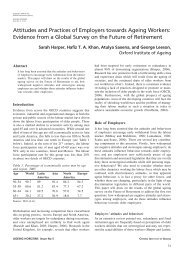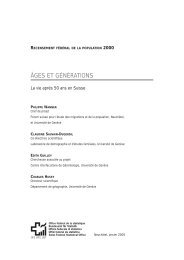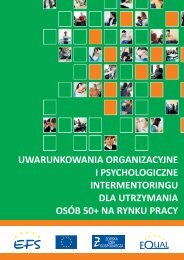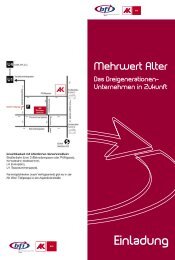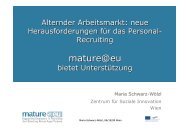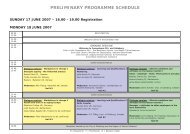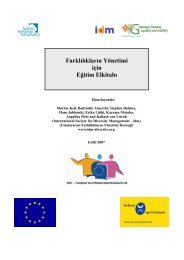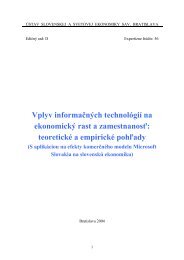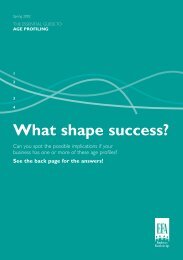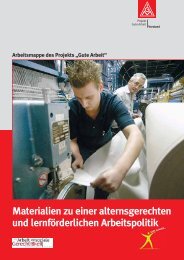EQF Assignment Report.pdf - Mature @ EU
EQF Assignment Report.pdf - Mature @ EU
EQF Assignment Report.pdf - Mature @ EU
You also want an ePaper? Increase the reach of your titles
YUMPU automatically turns print PDFs into web optimized ePapers that Google loves.
Workpackage 2 Description of learning outcomes in <strong>EQF</strong> terms<strong>Report</strong> on <strong>EQF</strong> Assignability1. General remarksFollowing the description of WP 2 within the accepted project proposal which defines theusability of mature@eu for the purposes of the learner,“It is an instrument of enhancing her/his abilities which should help to go further steps on a careerpath which possibly leads beyond the borders of the country where he/she is currently working.” 1This makes it sensible“to describe the learning outcomes of MATURE@<strong>EU</strong> on the basis of a Europe-wide recognizedlearning outcome oriented standard, understandable independently from national educationaltraditions, and useable as a grid for describing all kinds of qualifications: the European QualificationFramework (<strong>EQF</strong>).” 2It is understood that a Europe-wide understandable description of learning outcomesachieved by using mature@eu will enhance the motivation of possible mature@eu users toget qualified by using the learning platform, thereby at the same time advancing the agediversity initiative, which is the actual concern of the mature@eu project. This is in principle alegitimate expectation as it can be assumed that every qualification which has beendescribed in <strong>EQF</strong> terms will create benefits for those who possess a certificate confirming it:They can use it beyond the national context where they have achieved the qualification. Theofficial <strong>EQF</strong> document of the European Commission refers to this benefit:“The <strong>EQF</strong> will support greater mobility of learners and workers. It will make it easier for learners todescribe their broad level of competence to recruiters in other countries. This will help employersinterpret the qualifications of applicants and so support labour market mobility in Europe. “ 3Nevertheless, it should be considered that there are some issues which could at first glancereduce the value of assigning mature@eu to the <strong>EQF</strong>:1. Learning outcomes achieved with the help of mature@eu are not part of aqualification acquired within a specific national educational system. They are basedon tools which have already been developed in a European context. These tools havebeen adapted to national contexts, but only with regard to language and relevantinformation at national level. Therefore it cannot be argued that these learningoutcomes refer to a qualification which is already recognised in one country and thatthe <strong>EQF</strong> will help to make this qualification transparent in other European countries. Ifone gets recognition for this kind of “qualification” , depends first and utmost onwhether relevant stakeholders (i.e. those who decide on recruiting HRD managementpersonnel) accept its content i.e. whether they agree that age diversity managementis necessary for their organisation.2. The “MATURE@<strong>EU</strong> qualification” does not cover a whole occupational profile or acorresponding curriculum. It could not even be claimed that it represents an additionalqualification since the learning units available at the mature@eu learning platform1 See project proposal2 l.c.3 The European Qualifications Framework for Lifelong Learning (<strong>EQF</strong>),http://ec.europa.eu/education/policies/educ/eqf/eqf08_en.<strong>pdf</strong>, p.4
shall enable to modify already existing HRD tools (as writing job advertisements,design of application forms, guidelines for carrying out initial interviews, etc.). This is,of course, more sensible than to try to provide for some modules which can beconsidered tools for age diversity management besides traditional HRD: The successof the age diversity initiative is dependent upon integrating it as an attitude into HRDwhich thereby will lose its traditional age bias character.But this does not deliver real arguments for giving up the idea to assign mature@eu to the<strong>EQF</strong>. On the contrary, this legitimates to extend the scope of <strong>EQF</strong> assignment originallyforeseen within this project: It is sensible to relate to the <strong>EQF</strong> whole HRD professions (e.g.HRD manager, or assistant in the HRD department) in which age diversity orientation alreadyplays a crucial role.Occupational profiles of this kind, of course, do not yet exist, and therefore it makes sense toset up European core profiles of HRD professions which include age diversity orientation,and to describe them in <strong>EQF</strong> terms. This could help to set up or update comparable profilesat national level, and if those are publicly recognised ones, it would anchor the mature@euobjectives in the area of educational systems which would be a strong support for makingage diversity management an obligatory part of daily HRD work.Work of HRD people does, in principle, not differ from country to country. It should thereforealso not be too difficult to set up European HRD core profiles in terms of content to beconsidered. HRD experts from various countries, supported by the mature@eu team, wouldcertainly come to agreements without big difficulties. But this does not say anything about the(political) efforts necessary for the transfer of core profile features into national standardswhich would have to based on a sound partnership of relevant stakeholders (as socialpartners, public institutions, etc.), and it remains unconsidered that there are only fewpersonal resources available within the mature@eu project to fulfill the envisaged tasks.Nevertheless, in order to remain realistic in the widest sense of the word i.e. to think in termsof sustainability, it would not be a good decision to give up the above described holisticprofiling approach in favour of a short term solution which does not really cover the realneeds. Therefore a solution should be found which abides by the above described objectiveas a long term perspective 4 , but at the same time limits work within WP 2 according to thescope of the project.This can be achieved if the intended description of HRD profiles contains necessaryelements in a nutshell, and is detailed only with regard to the elements to which themature@eu learning outcomes are related to. As a first step, therefore the elements shouldbe identified which allow for more precise description on the basis of age diversityrequirements described within mature@eu learning units.4 possibly delivering the objectives of work in follow-up projects
2. <strong>Mature</strong>@eu learning outcomes and the <strong>EQF</strong> descriptorsAs already mentioned above, the tools available on the mature@eu learning platform shallenable learners to modify already existing HRD tools in order to achieve age diversityorientation. Dealing with these tools could be understood as participating in various parts ofa work process typical for specific HRD professions. This delivers the interface to the <strong>EQF</strong>descriptors. 5 : Knowledge, skills, and competence are described as work-related categories;nearly all descriptions of these terms provided in the official <strong>EQF</strong> document refer to “a workor study”. 6The mature@eu learning platform offers the possibility to participate in courses structured bylearning units related to three modules. For the purpose of <strong>EQF</strong> assignment, it is very usefulthat a description of abilities to be acquired by using these modules is delivered:Module 1: The drivers for changeWhen you complete this module you will be able to:1. Describe and communicate Europe's key demographic trends2. Identify <strong>EU</strong> and national laws against discrimination3. Outline the added value of age diversity4. Describe the benefit of older IT professionals5. Make a convincing case for age diversityModule 2: Making the Business CaseWhen you have completed this module you will be able to:1. Develop a business case for age diversity2. Convince decision makers of the need for an age diverse recruitment policy3. Enable your organisation analyse current and future employment profiles4. Analyse your organisation's existing recruitment policies5. Develop and communicate a formal policy statement against age related discriminationModule 3: Implementing age-diverse recruitment proceduresWhen you have completed this module you will be able to:1. Outline the general principles for age diverse recruitment2. Identify the key elements associated with training staff directly involved in the recruitmentprocess3. Create age neutral job descriptions4. Create age neutral adverts5. Design an age diverse application form6. Recognize age bias in traditional search strategies7. Ensure age bias free selection procedures8. Build an age-friendly employer reputation 75 See The European Qualifications Framework for Lifelong Learning (<strong>EQF</strong>)., Annex 26 l.c., Annex 27 See http://www.mature-project.eu
This list of learning outcomes shows references to work processes belonging to HRD, but notin a way that it directly mirrors the work process structure of a HRD profession: Someabilities to be acquired shall enable people to carry out age-diversity oriented work whichcould be considered a part of future HRD which already is based on the age diversityapproach (Module 3, 2-8), but there are also a lot of abilities required which refer to theimplementation of the age diversity approach (Module 1,1-5, Module 2,2). Implementation ofthis approach, of course, can also belong to standard tasks within future HRD workprocesses even if it is understood that this approach should be obligatorily be integrated infuture standardised HRD work processes (and therefore would not require separateimplementation activities any more): Since thinking in age-diversity-terms is not self-evidentnowadays, it will certainly remain an extra effort to orientate HRD work to this issue in theforeseeable future.But it can be doubted if all activities considered necessary today have to be taken in accountfor the design of standardised HRD professions. The extent of specified implementingabilities reflects the current situation where we are far away from general recognition of theage-diversity approach in all relevant areas. The situation will be different if we can assumethat age-diversity-orientation has become an obligatory element of publicly recognised HRDprofiles: In this case an ability like “Convince decision makers of the need for an age diverserecruitment policy” (Module 2, 2) will lose its importance since this need is no longer only aneed which can be neglected or accepted by managers, for this necessity will have achieveda legal character.It is also obvious that the kind of abilities indicated in the list differs in terms of knowledge,skills, and competence: Module 1,1-4 should be considered under the category knowledgewhereas Module 2 and in particular Module 3 refer to skills. This succession reflects a linkbetween knowledge and skills: Without specific knowledge I am not able to develop andapply specific skills, and therefore it makes sense to start mature@eu learning with acquiringpure knowledge; further procedure shows that this knowledge is an instrument to work aspeople with age-diversity-orientation skills.Thus the mature@eu learning modules already show that it is problematic to considerknowledge and skills isolated from each other as it might suggest the structure of the <strong>EQF</strong>.This becomes still more evident if we try to define the <strong>EQF</strong> level of considered knowledgeand skills: If we check the wide range of material made available within the units of Module 1,it turns out that knowledge is not clearly assignable only to one level: Shall we say thismaterial delivers• knowledge of facts, principles, processes and general concepts, in a field of work orstudy (level 3),• factual and theoretical knowledge in broad contexts within a field of work or study(level 4),• comprehensive, specialised, factual and theoretical knowledge within a field of work orstudy and an awareness of the boundaries of that knowledge (level 5), or• advanced knowledge of a field of work or study, involving a critical understanding oftheories and principles (level 6) 8 ?Even if we go more into details and talk, for example, about the <strong>EU</strong> and national laws againstdiscrimination, the decision becomes not easier: The definitions of knowledge at variouslevels concern whole sets of knowledge elements which as such mostly do not show aspecific character allowing to assign them to <strong>EQF</strong> levels. It is dependent upon the context inwhich these elements appear how they have to be judged, and this context is determined bythe purpose for which this knowledge is necessary i.e. for carrying out activities. This leadsus to skills: Skills describe the abilities of carrying into effect activities.8 The European Qualifications Framework for Lifelong Learning (<strong>EQF</strong>), Annex 2
It can therefore be said that skills steer the use of knowledge, and this perception does atleast not contradict to the descriptions of skills at corresponding <strong>EQF</strong> levels provided in theannex of the official <strong>EQF</strong> document:• a range of cognitive and practical skills required to accomplish tasks and solveproblems by selecting and applying basic methods, tools, materials and information(level 3)• a range of cognitive and practical skills required to generate solutions to specificproblems in a field of work or study (level 4)• a comprehensive range of cognitive and practical skills required to develop creativesolutions to abstract problems (level 5)• advanced skills, demonstrating mastery and innovation, required to solve complexand unpredictable problems in a specialised field of work or study (level 6) 9Level-distinctive features of descriptions of skills (highlighted in red) can obviously be relatedwithout difficulties to the features of knowledge descriptions at the same levels (where thelevel-distinctive features are highlighted in green); it can be understood that the solutions ofproblems to which the above mentioned skills refer can be acquired with the help ofcorresponding knowledge situated at the same level.But was said for knowledge, is also true for skills: There is no simple assignment solutionavailable. If we have a closer look at the distinctive features of skills levels, we discover thatthe terms used for description are relative: What has to be considered a basic method, aspecific problem, a creative solution, or an unpredictable problem in a specialized field,depends upon the state of the art for carrying out activities in a professional environment.With regard to HRD we have to consider that we are going to change this state of the artsince we want to become age-diversity-orientation an attribute of HRD. The status of theskills acquired with the help of mature@eu learning can only determined in terms of <strong>EQF</strong>levels if we make a decision about future HRD professions: With regard to age-diversityorientation, what shall be self-evident for such a profession in the near future, and what isconsidered a subject of implementation even if we assume that age-diversity orientation hasto be integrated into a legal standard of HRD profiles which shall be valid for all HRD (thusnot requiring extra implementation of age-diversity orientation as a whole)?It turns out that also the assignment of skills to <strong>EQF</strong> levels has to take in account issuesbeyond the actual list of level descriptions. It becomes visible that knowledge as well asskills achieved as mature@eu learning outcomes cannot sensibly be described in <strong>EQF</strong> termsif we try to assign them directly to <strong>EQF</strong> levels. Only if we apply a holistic approach whichsituates the application of required knowledge and skills in the framework of real workprocesses (not yet taking place as a rule in our case, but describable in concrete terms) wewill get a stable basis for determining the levels.As already alluded to above, this is possible on the basis of an occupational profile whichlinks required abilities systematically to the work process. If we succeed in creating aninterface between the <strong>EQF</strong> and the profile representing a totality of abilities related to the workprocess, we will have set up the decisive condition for assigning the mature@eu learningoutcomes to the <strong>EQF</strong>.The way to set up this link leads over an interpretation of the <strong>EQF</strong> category competence interms of the profession(s) at hand. The list of competences 10 differentiated according to thelevels referred to in the above quoted lists of knowledge and skills shows why this is possible:9 The European Qualifications Framework for Lifelong Learning (<strong>EQF</strong>), Annex II10 It shall not be concealed that the author of this paper is not happy with this term in this context since it is normally used in awider sense, as a term overarching all kinds of abilities. But since competence has been defined in the official <strong>EQF</strong> documentas a term with a specific meaning, related to responsibility and autonomy, competence is used in the same sense within thispaper. As a term for the overarching category, ability is used.
• take responsibility for completion of tasks in work or study; adapt own behaviour tocircumstances in solving problems (level 3)• exercise self-management within the guidelines of work or study contexts that areusually predictable, but are subject to change; supervise the routine work of others,taking some responsibility for the evaluation and improvement of work or studyactivities (level 4)• exercise management and supervision in contexts of work or study activities wherethere is unpredictable change review and develop performance of self and others(level 5)• manage complex technical or professional activities or projects, taking responsibilityfor decision-making in unpredictable work or study contexts; take responsibility formanaging professional development of individuals and groups (level 6). 11Work or study is the reference point for level distinction as in the lists of descriptions relatedto knowledge and skills. But it is important that the corresponding categories responsibilityand autonomy deliver criteria for the distinction of levels; it can therefore be claimed thatdescriptions in the column competence mirror the all-over organisation of work which is atthe very end relevant for determining the activities to be carried out and the abilities assignedto them: It can be seen that a model of relationships among individuals working on the samesubject is behind the above listed descriptions of competence, defining tasks on the basis ofa structure of work distribution from which competences can be derived in terms of levels.They are related to roles in the work process which in the past mostly have be considered bydefining occupational profiles.This allows, in principle, for making decisions with regard to the level of abilities required forcarrying out a “work or study”. Looking at the above indicated descriptions of competences indetail, we can see, for example, that the manager of a big enterprise HRD department willcertainly need competences situated at level 6; following the arguments indicated above, thiswill imply decisions about the level of knowledge and skills related to them.In order to be able to decide about the whole range of HRD professions with regard to the<strong>EQF</strong> level of required abilities, it will be necessary to get a clearer picture of the distributionof work in this field according to best practice: Structures of work organisation should reflectthe objective of work in an ideal way. If it is possible to describe work organisation as asystem which ensures that everybody participating in a specific work or study contributes to amaximum extent to achieving the objective of this work or study on the basis of the rolewhich was determined for her/him, it will be possible to define the according specificcompetences at various levels.The reference objective approach 12 shows a way to proceed as described above: <strong>EQF</strong>descriptors are concretised by relating them to the work process to be considered anensemble of activities, not carried out as separately ongoing operations, but as parts of awork structure which is determined by a common work objective, understood as the intentionto produce specific goods or to deliver specific services. In terms of abilities required forfulfilling the tasks within this structure, an equivalent can be determined by a work-relatedinterpretation of the <strong>EQF</strong>-descriptor competence which at all levels includes reference to awork or study: If this work or study is understood in the above described objective-orientedway, a reference objective, typical for a specific profession, can be defined as the ability to11 The European Qualifications Framework for Lifelong Learning (<strong>EQF</strong>)., Annex 212 This approach was suggested by the author within two projects dealing with the set-up of <strong>EQF</strong> assigned sectoral frameworksin the automotive sector (European Automotive Sector Competence Meta-Framework and CarEasyVET) and presented at aCEDEFOP seminar in January 2009, see http://www.eascmf.eu and http://www.careasyvet.net; The LEONARDO ProjectEuropean Automotive Sector Competence Meta-Framework, Synthesis <strong>Report</strong>, p.8 ff; Gerald Thiel, Reference Objectives ofOccupational Profiles, An <strong>EQF</strong>-conform functional approach of description, Presentation on behalf of DEKRA Akademie at theCEDEFOP seminar “Qualifications – from Provisions to Frameworks”, Thessalonica 23.01.2009 [The report and thepresentation will be made available by the author]
fulfill tasks oriented to achieve a predefined work objective at one of the <strong>EQF</strong> levels, definedby the degree of responsibility and autonomy.The objective orientation of the <strong>EQF</strong> category competence has consequences for theunderstanding of the other <strong>EQF</strong> categories knowledge and skills: They are no longer to beconsidered independently from competence, but related to it in a functional way, interpretedas instruments to achieve the reference objective. This determines the relationship betweenwork and the abilities required to carry it out in a way as it is depicted in the picture below.Work SubjectsKnowledgeWorkInstrumentsWorkObjectiveReferenceObjectiveWorkRequirementsSkillsFig.1 The work process mirrored in the required abilitiesWork subjects describe that what the specific work is about, work instruments the tools to be used toachieve the work objective, work requirements the conditions under which work will take placesuccessfully.If we apply this approach to HRD as a specific work or study, we have at first to determinethe work objective of HRD. It is suggested to define this as the objective to continuouslyprovide for an optimum skilled workforce for the enterprise, able to fulfill the workrequirements of the enterprise to a maximum extent. The corresponding reference objectivewould be the competence to reach this work objective, differentiated in terms of <strong>EQF</strong> levels,with regard to work using words like contribute to, organise, supervise, work autonomously,etc. which suit the <strong>EQF</strong> level descriptions of competence and at the same time reflect thespecific work organisation of HRD.Work organisation has to be considered a part of the work requirements. To describe themproperly (as well as work instruments) requires to have a closer look at HRD (the worksubject) as it is possible in the framework of this report. Therefore a list of sustainable HRDreference-objective-relateddescriptions differentiated in terms of <strong>EQF</strong> levels cannot bedelivered within the report at hand.At this stage of project work, it is only possible to set up an ad-hoc model of a HRD workobjective based on easily accessible material (descriptions of occupational profiles,descriptions of mature@eu learning units). From this provisional model provisional HRDreference objectives should be derived which could create the basis for the development offurther project deliverables foreseen in WP 2.Gerald Thiel


